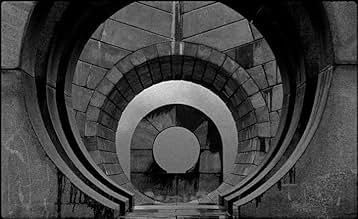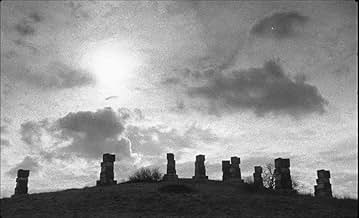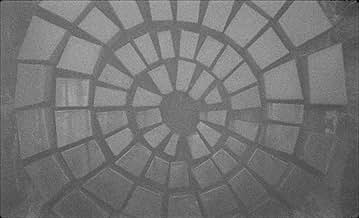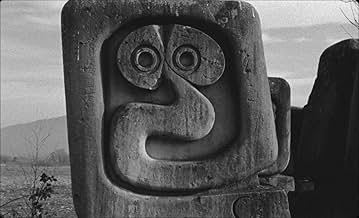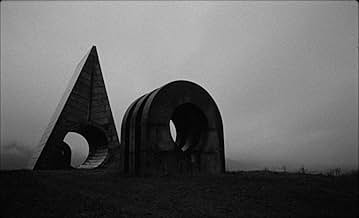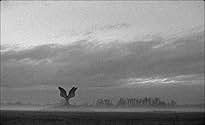Last and First Men
- 2020
- 1h 10min
CALIFICACIÓN DE IMDb
6.7/10
4.9 k
TU CALIFICACIÓN
Dos billones de años en el futuro, la humanidad está al borde de la extinción. Todo lo que les queda es un mundo solitario de monumentos surrealistas que ilustran su significado a un mundo s... Leer todoDos billones de años en el futuro, la humanidad está al borde de la extinción. Todo lo que les queda es un mundo solitario de monumentos surrealistas que ilustran su significado a un mundo salvaje.Dos billones de años en el futuro, la humanidad está al borde de la extinción. Todo lo que les queda es un mundo solitario de monumentos surrealistas que ilustran su significado a un mundo salvaje.
- Dirección
- Guionistas
- Elenco
- Premios
- 2 premios ganados y 5 nominaciones en total
- Dirección
- Guionistas
- Todo el elenco y el equipo
- Producción, taquilla y más en IMDbPro
Opiniones destacadas
I wouldn't really regard nor describe this as a film, but a great art installation piece. The music is fantastic & contemplative & complements the visuals completely & it does project you into another worldly experience along with the narration of Tulsa Swinton. Unsurprisingly it is mainly a vehicle for the composition of sounds & is surprisingly hypnotic. Best experienced BIG, DARK & LOUD.
With the summer movie season of 2020 being drier than sandpaper (thanks to our good friend COVID), the season of banking on streamed releases has been all the more exciting. Through September, we've already enjoyed I'm Thinking of Ending Things, the documentary Feels Good Man, the return of Amazon's The Boys, and that one French Netflix film about dancing or whatever. I understand there's also more Borat coming up.
But the one that truly caught me off guard was Last and First Men - an Icelandic film that was actually completed over three years ago, stars no people bar narrator Tilda Swinton, and was directed by Jóhann Jóhannsson, the late composer who scored 2018's Mandy as his final effort (which I still say deserved a farewell-Oscar).
Last and First Men plays like a documentary from the distant future, yet is so minimalistic in its unearthly footage that it feels more like a visual audiobook, narrated by Swinton with the same gravitas that Cate Blanchett gave Malick's Voyage of Time - albeit darker and more aware of the Earth's mortality. It is fair to say that "nothing happens" in the movie, and if your measurement of quality reduces itself to "number of things happening", close this window so I can proceed in peace.
What we see is a monochromatic series of alien structures, set to narrations that explain how humanity evolved after the "First Men"; that is, you and I. The message being broadcast to us is from the almost superpowered Last Men. The sun is dying, killing itself without care for the superhumans we've become: a collective communicating mainly with the mind and engaging in sex or intimacy only when a new step on the evolutionary ladder may be possible - we learn that pregnancies last 20 years and infancies a century.
Without giving too much away, we also learn that, in a sense, accepting the inevitability of doom - a reality that persists even if we, the insignificant Sol 3 bipeds, successfully achieve immortality and higher awareness - made us "truly" human and connected again. This is all very intriguing, and I want to say that the ambiance of Jóhannsson's imagery and sound made it hypnotizing to take in. Alas, I do think the film itself winds up repetitive, at least visually.
Perhaps I shouldn't quite think of it as a film. It has been repeatedly referred to as a "multimedia project" that may be best enjoyed as an art installation with a live orchestra (the film does have an absolutely superb musical score). This might remind some cinephiles of Matthew Barney's Cremaster Cycle, which is one of the few properties I can safely call "pretentious" without feeling as if I'm using the word as a get-out-of-thinking free card.
Last and First Men is hardly so pointless; it has something to communicate and the images of empty desolation are ultimately fitting, given that this is meant to be a message sent to our astronomers from a close-to-apocalyptic future. It's all part of the point (I also understand keeping things minimal with something as unfilmable as the sheer smallness of human existence next to the lifespan of the cosmos, which may as well be left to our already limited imagination). The problem is that some of these structures and locations, while impressive on an SFX level, start to look a bit samey.
Even so, I will have this piece on my mind for a while. It is a journey to the future of man that you won't soon forget. The question is if you'll want to go again.
But the one that truly caught me off guard was Last and First Men - an Icelandic film that was actually completed over three years ago, stars no people bar narrator Tilda Swinton, and was directed by Jóhann Jóhannsson, the late composer who scored 2018's Mandy as his final effort (which I still say deserved a farewell-Oscar).
Last and First Men plays like a documentary from the distant future, yet is so minimalistic in its unearthly footage that it feels more like a visual audiobook, narrated by Swinton with the same gravitas that Cate Blanchett gave Malick's Voyage of Time - albeit darker and more aware of the Earth's mortality. It is fair to say that "nothing happens" in the movie, and if your measurement of quality reduces itself to "number of things happening", close this window so I can proceed in peace.
What we see is a monochromatic series of alien structures, set to narrations that explain how humanity evolved after the "First Men"; that is, you and I. The message being broadcast to us is from the almost superpowered Last Men. The sun is dying, killing itself without care for the superhumans we've become: a collective communicating mainly with the mind and engaging in sex or intimacy only when a new step on the evolutionary ladder may be possible - we learn that pregnancies last 20 years and infancies a century.
Without giving too much away, we also learn that, in a sense, accepting the inevitability of doom - a reality that persists even if we, the insignificant Sol 3 bipeds, successfully achieve immortality and higher awareness - made us "truly" human and connected again. This is all very intriguing, and I want to say that the ambiance of Jóhannsson's imagery and sound made it hypnotizing to take in. Alas, I do think the film itself winds up repetitive, at least visually.
Perhaps I shouldn't quite think of it as a film. It has been repeatedly referred to as a "multimedia project" that may be best enjoyed as an art installation with a live orchestra (the film does have an absolutely superb musical score). This might remind some cinephiles of Matthew Barney's Cremaster Cycle, which is one of the few properties I can safely call "pretentious" without feeling as if I'm using the word as a get-out-of-thinking free card.
Last and First Men is hardly so pointless; it has something to communicate and the images of empty desolation are ultimately fitting, given that this is meant to be a message sent to our astronomers from a close-to-apocalyptic future. It's all part of the point (I also understand keeping things minimal with something as unfilmable as the sheer smallness of human existence next to the lifespan of the cosmos, which may as well be left to our already limited imagination). The problem is that some of these structures and locations, while impressive on an SFX level, start to look a bit samey.
Even so, I will have this piece on my mind for a while. It is a journey to the future of man that you won't soon forget. The question is if you'll want to go again.
Rarely did the visuals match the story and music so I essentially listened to this. The score was nearly perfect and the story was quite compelling. As art, I liked it quite well. As a film, it wasn't very good. 36 hours later I'm still thinking about it.
This is a beautiful art/science/philosophy installation music film by Icelandic composer Jóhann Jóhannsson released after his death in 2018, from a haunting text by the British philosopher and writer Olaf Stapledon, known by his "science fiction" in the first half of the 20th-Century. It's narrated by Tilda Swinton, who conveys greatly the tone of a once and future humanity (a post-humanity, if you will). The visuals are provided mostly by brutalist Soviet concrete architecture from the former Yugoslavia.
Apparently the film is being marketed by some quarters like some sort of kind of post-apocalyptic sci-fi pic, and apparently kids are watching it with expectations of seeing the likes of Mad Max (which is a great series of films, anyway) or Ready Player One or who knows what kind of zombie crap. This is not it, and you can then laugh at their perplexed and resentful reviews giving the film 1 star. No, nope, nope. What were they sold? This is not World War Z, nor the Time Machine. Think, if of anything, of Guy Debord's films, John Berger, Soviet films, think of Paul Virilio's Bunker Archaeology, think of the visuals and soundtrack for T. S. Eliot's serious poems (not "Cats", of course), etc. Think of Cosmos or 2001: A Space Odissey, if you want. Think of a documentary. Think of a museum exhibit. Think of a manifesto for post-humanity. Think of archaeology in 2 Billion AD... but for Pete's sake, when you get into watching this film, stop thinking you are entering a McDonald's or a Chuck E. Cheese when you come in into The Met or a Guggenheim museum.
Apparently the film is being marketed by some quarters like some sort of kind of post-apocalyptic sci-fi pic, and apparently kids are watching it with expectations of seeing the likes of Mad Max (which is a great series of films, anyway) or Ready Player One or who knows what kind of zombie crap. This is not it, and you can then laugh at their perplexed and resentful reviews giving the film 1 star. No, nope, nope. What were they sold? This is not World War Z, nor the Time Machine. Think, if of anything, of Guy Debord's films, John Berger, Soviet films, think of Paul Virilio's Bunker Archaeology, think of the visuals and soundtrack for T. S. Eliot's serious poems (not "Cats", of course), etc. Think of Cosmos or 2001: A Space Odissey, if you want. Think of a documentary. Think of a museum exhibit. Think of a manifesto for post-humanity. Think of archaeology in 2 Billion AD... but for Pete's sake, when you get into watching this film, stop thinking you are entering a McDonald's or a Chuck E. Cheese when you come in into The Met or a Guggenheim museum.
I rarely watch arthouse films, and I seldom enjoy the few that I see. Yet somehow, I found myself captivated by this one. Partly because I had read Stapledon's book not too long ago, and been impressed by its vast scope. I found the strange way this film represents the story intriguing.
As others have said, on the surface this is 70 minutes of slow pans and zooms on strange concrete sculptures. The kind of style over substance that could easily be dismissed as pretentious navel-gazing. But for me, at least, it worked.
The core purpose of the visuals, I think, is to create a sense of alienation, of peering into a distant future world that we cannot fully grasp, through a medium - cross-time telepathy - that we are not built to comprehend. The film is made not as a story to be watched, but as if it were an actual telepathic message from the narrator, one of the last living men, waiting for the inevitable end of all of humanity in a future two billion years away.
This is not for everyone, and I won't disparage any of the 1 star reviews here. But if you "click" with what this film is trying to accomplish, it can be quite enjoyable.
As others have said, on the surface this is 70 minutes of slow pans and zooms on strange concrete sculptures. The kind of style over substance that could easily be dismissed as pretentious navel-gazing. But for me, at least, it worked.
The core purpose of the visuals, I think, is to create a sense of alienation, of peering into a distant future world that we cannot fully grasp, through a medium - cross-time telepathy - that we are not built to comprehend. The film is made not as a story to be watched, but as if it were an actual telepathic message from the narrator, one of the last living men, waiting for the inevitable end of all of humanity in a future two billion years away.
This is not for everyone, and I won't disparage any of the 1 star reviews here. But if you "click" with what this film is trying to accomplish, it can be quite enjoyable.
¿Sabías que…?
- TriviaThe structures shown throughout the film are called Spomeniks. They are former Yugoslavian World War II monuments and memorials built starting in 1945 and continuing throughout the 1970s. Their architectural style is called Brutalist, which uses minimalist construction and emphasizes the raw building materials and structural elements over more decorative types of design. They were commissioned to and designed by many different notable sculptors from the area. They were mostly abandoned since the Yugoslav Wars and the dissolution of Yugoslavia in the early 1990s.
Selecciones populares
Inicia sesión para calificar y agrega a la lista de videos para obtener recomendaciones personalizadas
- How long is Last and First Men?Con tecnología de Alexa
Detalles
Taquilla
- Total a nivel mundial
- USD 13,475
- Tiempo de ejecución
- 1h 10min(70 min)
- Color
- Relación de aspecto
- 1.66 : 1
Contribuir a esta página
Sugiere una edición o agrega el contenido que falta



